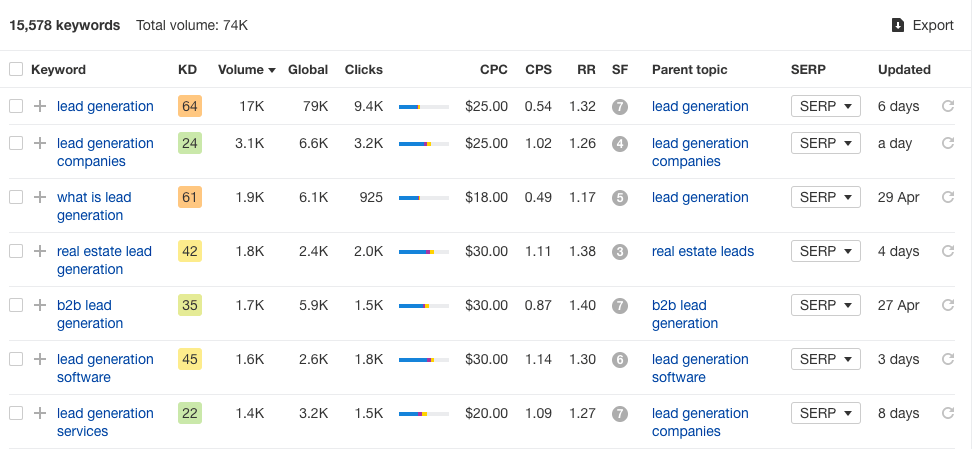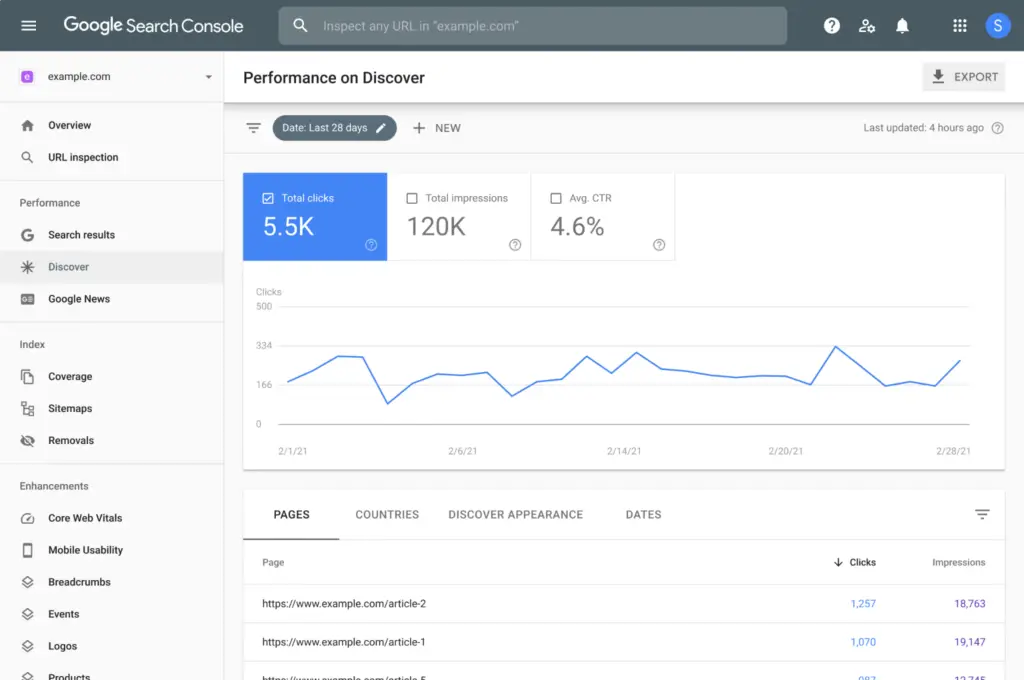Want to sell with content? That’s a great idea. Once you publish content, it can drive conversions on autopilot for a long time. In this article, we’re going to walk you through 10 essential steps to create and optimize content for conversions. Creating such awesome content takes some effort, though. But no worries: you don’t have to be a content writing veteran to create something that converts well. Be strategic, organized, and cover all bases—and your content will be great.
10 Easy Steps to Write a Sales Copy That Converts:
1. Do Empathy Research
Empathy research is a term some writers use to describe the process of researching the reader’s needs, problems, and goals. Doing empathy research helps the writer understand what the reader might want to see in their copy, so it’s a good idea for marketing texts.
Let’s suppose you need to write an article about lead generation. This article will be published on a blog to attract organic leads from Google and convince them to try a lead generation product.
You can take these steps to conduct empathy research:
- Read about the experiences of others: Online forums like Quora and Reddit have numerous threads where business owners discuss their experiences with lead generation (see the image below). Reading about these experiences will help you understand the situation of the target reader and make you more confident about your ability to help.
- Study customer research: If you’re a part of a company, consider using customer research. Surveys, interviews, questionnaires, and so on — find relevant documents and learn about customer experiences
- Learn studies by others: There is a treasure trove of case studies, reports, and research on lead generation online. Visit the sites of your competitors and reputable marketing research organizations and find customer research they share on their websites.
Empathy research sounds like a time-consuming process, but it doesn’t have to be. If the copy you’re writing is a blog article, then consider investing no more than a couple of hours. But if you’re writing a copy for an email marketing campaign to increase sales, then this time might be a bit longer.
In any way, once you’re done with empathy research, you’ll be much more knowledgeable about your target reader’s goal. So you’ll be able to write faster and provide relevant advice. But there’s one more step before we actually can start writing the copy.
2. Research Keywords
SEO keyword research is a process of finding and choosing keywords to drive organic traffic from search engines. It’s the essential technique for selling online because it ensures that potential customers will discover a website. Keyword research can be done in several ways.
See Also: How Can I Get More Traffic to My Website for Free?
The best way is to use a keyword research tool like Ahrefs or SEMRush. They can provide you with a list of relevant keywords to use in your copy to attract more potential customers. Learning how to use keyword research tools takes little time, but it’s worth it.
The process is pretty straightforward. You need to;
- Choose the main keyword
- Extract all the secondary keywords
- Put all of them in one doc
Those selected keywords will be useful during writing. Here are the keywords Ahrefs recommended for the “lead generation” main keyword.

Another way to research keywords is using Google. This is a good technique if you have no access to keyword research tools (which are paid most of the time).
You can use Google’s tools in several ways.
The first and the most straightforward one is to type a keyword in Google’s search bar. It will give you keyword suggestions.

Another way includes using Google Search Console. It shows lots of relevant keywords that you can get a higher ranking for along with the number of impressions. Give it a try!
“Your website ranks for a certain number of keywords, so you can find them in the Console,” says Megan Amendola, an expert copywriter from EssayShark. “A great thing about this tool is that it gives many keywords with search volumes, which is extremely useful.”
In any way, collect all the keywords you find in one doc. Categorize them into groups according to their search volume and intent.
Related: What Tools Do You Need for SEO?
3. Create a Keyword-Informed Outline
The keywords you collected will help you to create an outline. It’s a structure of the future article used to provide a logical flow and organization.
Let’s suppose your keyword file contains these items:
- Lead generation
- LinkedIn lead generation
- What is lead generation
- Lead generation software
- Facebook lead generation
- Online lead generation
- Lead generation strategies
You can use these keywords as headings and structure the article. There are a few types of headings — H1, H2, H3, H4, and H5 — with H1 being the article’s title and H5 being the title of the smallest section.
Here’s how that structure might look like:
- H1 (Title): Lead Generation Guide
- H2. What is online lead generation?
- H2. 10 Lead Generation Strategies
- H3. LinkedIn lead generation
- H3. Facebook lead generation
- H2. Lead Generation Software
You can mix and change the structure in any way you like. The only important thing is to keep it focused on single search intent: “Learn about lead generation.”
Use this outlining technique to keep your writing organized and help readers navigate your content easier. You can apply it to many content types: articles, reports, landing pages — basically any long-form content for conversions.
4. Write How People Speak
Use natural, conversational language in your content. It’s an excellent way to make content easy to read and understand, which is essential for conversions.
To simplify writing:
- Write in a conversational language — the way you’d speak to a friend
- Refer to the reader with “you” and “yours”
- Divide long sentences into two or even more
- Keep the verb close to the subject
- Mention only one idea per sentence
To check your text for simplicity, read it out loud to someone. If they stop you and ask questions, consider simplifying your text in those parts.
5. Use Words Your Audience Understands
This tip is about avoiding or minimizing professional vocabulary and jargon that many people might not understand. Unless you’re writing for an audience that understands very specific professional words, consider replacing them with more straightforward alternatives.
Example:
Here are some marketing jargon words:
- Backlink — a link from one site to another
- Customer journey — a process a customer goes from finding a product to buying it
- CRM — customer relationship management system, an app that stores customer data for marketing and service purposes
- Lead nurturing — a process of providing leads with useful information that highlights the brand’s expertise and educates them about a topic they find interesting
Should you use some complex or profession-specific words, explain their meaning right away. It’s a good technique, in case there’s no way to avoid their use, but make sure to research your target reader’s knowledge before writing the copy.
Recommended: How Do You Measure the Success of Your Local SEO Campaign?
6. Add Visuals
A picture is worth a thousand words — that is so true in writing for marketing. Visuals can support writing in many ways and help readers understand complex ideas.
That’s why using visuals in marketing copy is a must. But you can take it one step further. Consider creating your unique visuals. It’s a technique that professional writers use to beat the competition and deliver something more unique and helpful.
Don’t worry about your skills as a graphic designer. Visuals can be pretty straightforward to make thanks to modern tools like PicMonkey alternatives or Photoshop free alternatives. These tools provide images, icons, and other elements needed to create visuals just by dragging and dropping them on a background.
Another way to create unique visuals is by taking screenshots. The article you’re reading right has used several of them already, and they were great to illustrate points made in the text.
See Also: Is Headless CMS Good for SEO (Google Page Experience Update)?
7. Put CTAs in the Right Places
CTAs can be buttons or text that encourages readers to convert. This is how we sell with content, so using CTAs properly is a must. Their placement is the most important thing. If a CTA feels out of place, the reader might perceive content as pushy and salesy, like an annoying salesperson.
Example:
This CTA is located at the end of a landing about Popup Maker’s features. The page lists all the features first, and when the visitors read them, they are presented with the CTA.

Another important consideration is CTA’s text.
As mentioned, CTAs can be buttons or textual. Make sure that yours aren’t pushy and resemble a reader’s intent.
Example:
This article about techniques to get Shopify sales has a CTA added to a section about email marketing. That’s why the text mentions emails and Shopify sales. The text “Try for free” tries to convince the reader that there’s no charge associated with converting.

Your texts can have multiple CTAs to give more opportunities to convert readers.
The number of CTAs and their placement really depends on the type of text. For example, a blog article might have one or two CTAs, while a landing page can have more than two.
8. Back-Up Your Claims with Research
Cite the sources of your claims, statistics, suggestions, and tips. For example, if you’d like to say that businesses have been successful with lead generation through popups, find a statistic that supports this claim.
Example:
this article about email marketing strategies cites a study of Campaign Monitor company to support the tip about emails marketing. There’s a study and even a visual to prove the point, which is very professional and makes the tip trustworthy.
Stats and tips make content more trustworthy and helpful, so back them up with real sources of information. This will increase the credibility of your content and its ability to convert customers.
9. Edit Until Perfect
At this point, your first draft is pretty much done. Nice job! There’s only one last step to take—and it’s a really important one: editing.
You have two options: submit the copy to an editor or make edits yourself.
If you have an opportunity to work with an editor, send them your copy and ask to provide feedback. An editor will take care of the readability, tone, flow of text, and other crucial aspects. Having another person read and improve text is a huge advantage, so definitely use it.
Have no editor to provide feedback? No problem.
You still can improve your own text. Once you’re done with content writing and proofreading, close up your laptop and do something else. Go to a park, meet with friends, play with a dog, do anything to ensure there’s some distance between you and the draft.
After you cleared your head, get back to the draft and start editing. The time you two spent apart was needed to help you rest so that you can make improvements. Read the copy once again and see what can be trimmed or expanded.
Many writers are excellent editors of their own work, and they use this self-editing technique. But regardless of the way you choose for editing, be sure to lay your eyes on it one more time before approving the copy.
10. Monitor Content Performance
Once the piece has been published, you can start tracking views and conversions.
If the copy you wrote was for a landing page, use a keyword research tool to find which keywords it ranks for—also, monitor conversions (email sign-ups, purchases, etc.) based on tracking and reporting features.
But, if you wrote a marketing article, use a keyword research tool to see which keywords it gets from Google. In case, you have no access to a tool, no problem. Make use of Google Analytics and Google Search Console to track traffic and conversions.
Here’s the view of the Google Search Console dashboard. It shows the total number of clicks, impressions, and the average click-through rate of a site.

If your marketing copy is not performing well, consider making revisions.
Changing meta titles and descriptions to add more relevant keywords is the easiest revision idea for marketing blog articles. You might have to improve keyword research or get some ideas for similar well-performing content pieces in this case.
Writing Sales Copy for Conversions: Summary
A lot of work goes into the creation of content for conversions. The best content is simple, easy to understand, provides proof, has CTAs, and considers the target reader’s needs. This strategy will give you the best chance to generate conversions in any industry.





